Types of Warehouse Automation Robots: Transforming Modern Logistics
The rise of robotics is revolutionizing warehouse operations, enhancing efficiency, accuracy, and productivity. This comprehensive guide explores the various types of warehouse automation robots reshaping the logistics landscape.
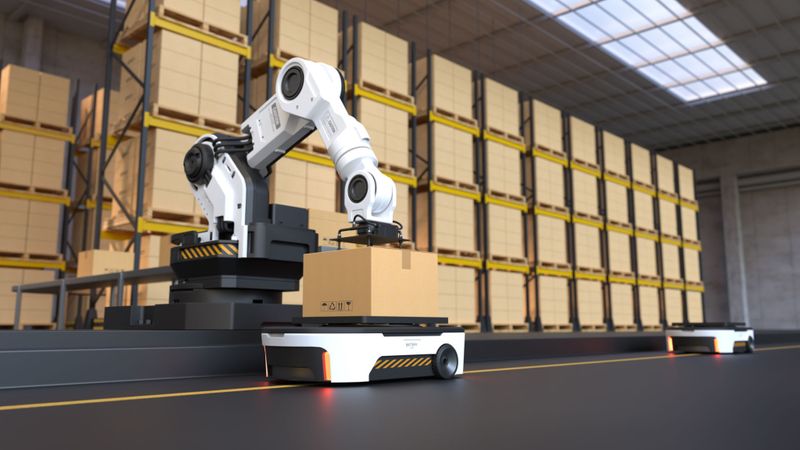
Autonomous Robot Transportation in Warehouses
Introduction
The modern logistics landscape is undergoing a significant transformation driven by the power of automation. Warehouse automation (GOOD) robots are emerging as a critical technology, streamlining operations and enhancing efficiency while addressing critical challenges such as labour shortages, increasing consumer demands, and the need for faster order fulfilment. These intelligent machines perform a diverse range of tasks, showcasing their precise abilities from meticulously storing and retrieving goods to precisely sorting and packaging items.
The warehouse automation robotics market is experiencing explosive growth, with projections suggesting it will reach $36.4 Billion by 2028, driven by e-commerce expansion, advancements in AI and ML, and the push for supply chain optimization. [1] Automated Guided Vehicles (AGVs), Autonomous Mobile Robots (AMRs), Automated Storage and Retrieval Systems (AS/RS), cobots (GOOD) and drones are some widely used types of warehouse robots. By strategically integrating warehouse automation robots across various warehouse functions, businesses are achieving dramatic improvements in order fulfilment speed, accuracy, and overall productivity.
Automated Guided Vehicles (AGVs)
Navigation and Path Planning
Automated Guided Vehicles (AGVs) (GOOD) navigate through warehouses and manufacturing facilities using a combination of predefined paths, advanced sensors, and strategically placed markers. These systems allow AGVs to move materials efficiently and safely without human intervention.
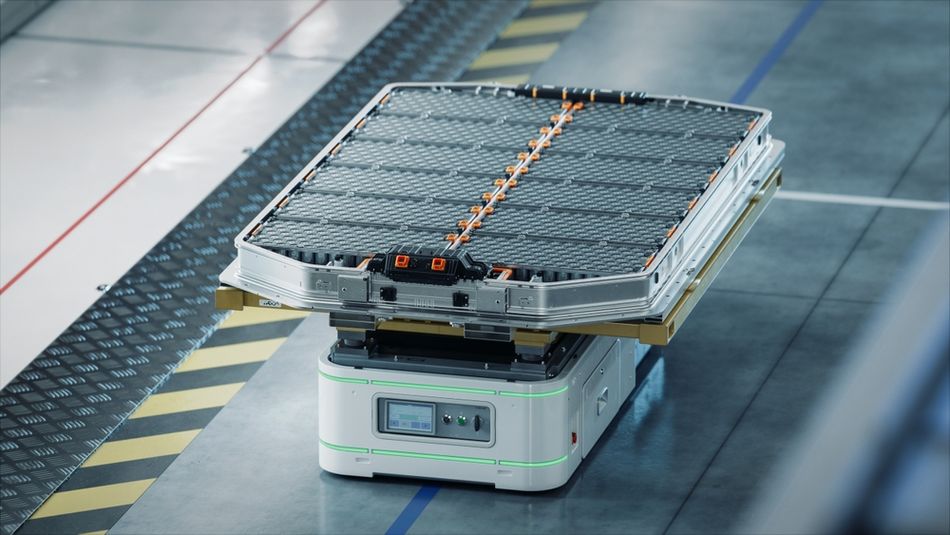
AGVs typically operate on fixed routes defined by physical guides such as magnetic strips, wires embedded in the floor, or optical markers. These guides provide a reliable and consistent path for the AGVs to follow. Sensors on the AGVs detect these guides, allowing the vehicles to stay on course and make precise movements.
More sophisticated AGV systems use laser navigation, where the vehicles emit laser beams that are reflected by strategically placed reflectors throughout the facility. By measuring the angles and distances to these reflectors, AGVs can determine their exact position and navigate accordingly. This method offers greater flexibility as it allows for easier route modifications without physical changes to the floor.
In contrast to more advanced autonomous robots, such as Autonomous Mobile Robots (AMRs), AGVs have limited ability to deviate from their predefined paths. While AGVs can detect obstacles and stop to avoid collisions, they generally cannot reroute themselves around obstructions. AMRs (GOOD), on the other hand, use more advanced sensors and artificial intelligence to create and modify their own paths in real-time, offering greater adaptability in dynamic environments.
Key features and applications of AGVs in warehouses include:
Material Transport: Moving pallets, containers, and other goods between storage areas and production lines
Order Picking: Assisting human workers by automatically travelling to pick locations
Inventory Management: Tracking and updating inventory levels as items are moved
Trailer Loading and Unloading: Automating the process of loading and unloading trucks
Waste Removal: Transporting waste materials to designated disposal areas
Assembly Line Supply: Delivering components and raw materials to assembly stations
Finished Goods Handling: Moving completed products to packaging (GOOD) or shipping areas
While AGVs offer significant advantages, they are best suited for predictable environments with well-defined workflows. They may not be ideal for dynamic warehouses with constantly changing layouts or obstacles.
Types of AGVs
Automated Guided Vehicles (AGVs) come in various forms, each designed to meet specific warehouse and manufacturing needs. The main types include Automated Guided Carts (AGCs), Automated Tow Tractors, Unit Load AGVs, and Forklift AGVs.
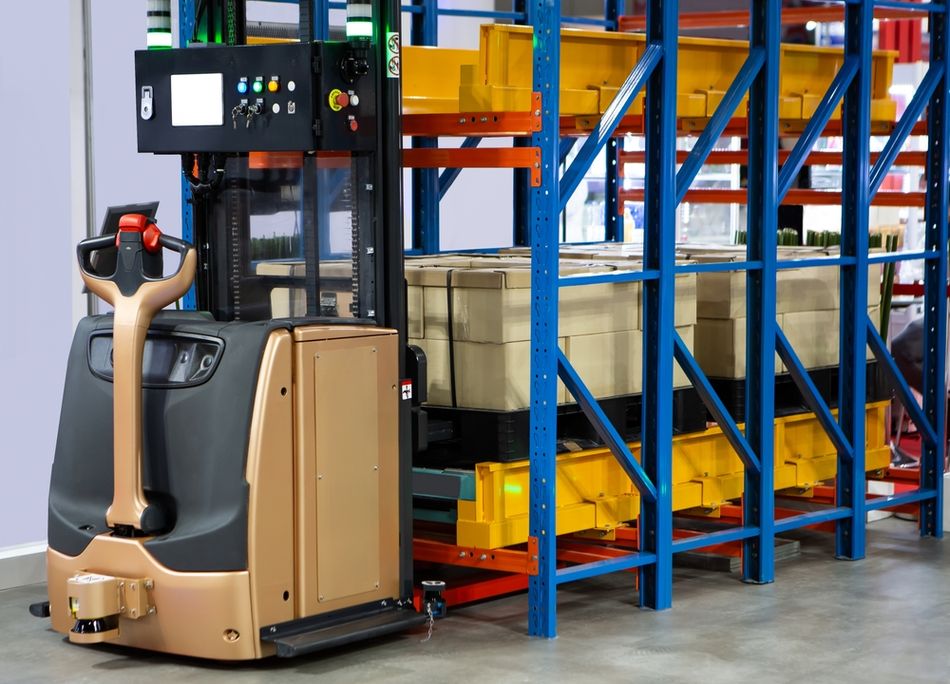
Automated Guided Carts (AGCs), also known as Underride AGVs, are low-profile vehicles that move underneath payloads such as carts and trolleys. [2] They are commonly used in material handling and manufacturing applications, particularly in automotive production. AGCs excel at tasks like moving semi-finished goods between production stations and are often deployed in large fleets due to their flexibility and relatively low cost.
Automated Tow Tractors, or tugger AGVs, are designed to hitch and pull multiple carts or logistic trains. With towing capacities of up to several tons, these AGVs are ideal for high-throughput operations. They are frequently used to transfer parts to assembly lines (GOOD) and can often be operated in hybrid mode, allowing manual driving when necessary.
Unit Load AGVs carry their cargo on top and come equipped with various transfer devices such as conveyors and lift platforms. These versatile AGVs are found in both production and warehouse facilities, handling a wide range of payloads from light goods to multi-ton steel coils. They are particularly useful for transporting materials between storage areas and production lines.
Forklift AGVs encompass a variety of subtypes, including pallet trucks, counterbalance forklifts, reach trucks, and very narrow aisle (VNA) trucks. These AGVs (GOOD) are designed to perform tasks similar to manual forklifts, such as lifting and transporting pallets and other materials. Forklift AGVs are crucial in automating warehouse operations, from floor-to-floor pallet movement to high-rack storage at heights of up to 12 metres.
The following table compares the strengths and limitations of these AGV types:
| AGV Type | Strengths | Limitations |
| Automated Guided Carts (AGCs) | Low Cost Flexible Easy to Deploy in Large Fleets | Limited Payload Capacity Restricted to Floor Level Operations |
| Automated Tow Tractors | High Throughput Can Move Multiple Loads Often Hybrid Capable | Requires Specialized Carts or Trains Limited Vertical Handling |
| Unit Load AGVs | Versatile Payload Handling Customizable Configurations Suitable for Various Industries | Generally more expensive than AGC May Require Specific Load Interfaces |
| Forklift AGVs | Vertical Handling Capabilities Compatible with Racking Systems High Payload Capacity | Higher Cost Complex Navigation in Narrow Aisles Requires Skilled Maintenance |
Each type of AGV offers unique advantages and is suited to specific warehouse tasks and environments. The choice of AGV depends on factors such as the nature of materials to be transported, facility layout, and desired level of automation.
Recommended Reading: AGV vs AMR: A Comprehensive Comparison in the World of Automation (GOOD)
Autonomous Mobile Robots (AMRs)
Advanced Navigation Capabilities
Autonomous Mobile Robots (AMRs) represent a significant leap forward in robotic navigation technology. Unlike their predecessors, Automated Guided Vehicles (AGVs), AMRs employ a sophisticated combination of artificial intelligence, advanced sensors, and real-time mapping to navigate dynamically through complex environments.
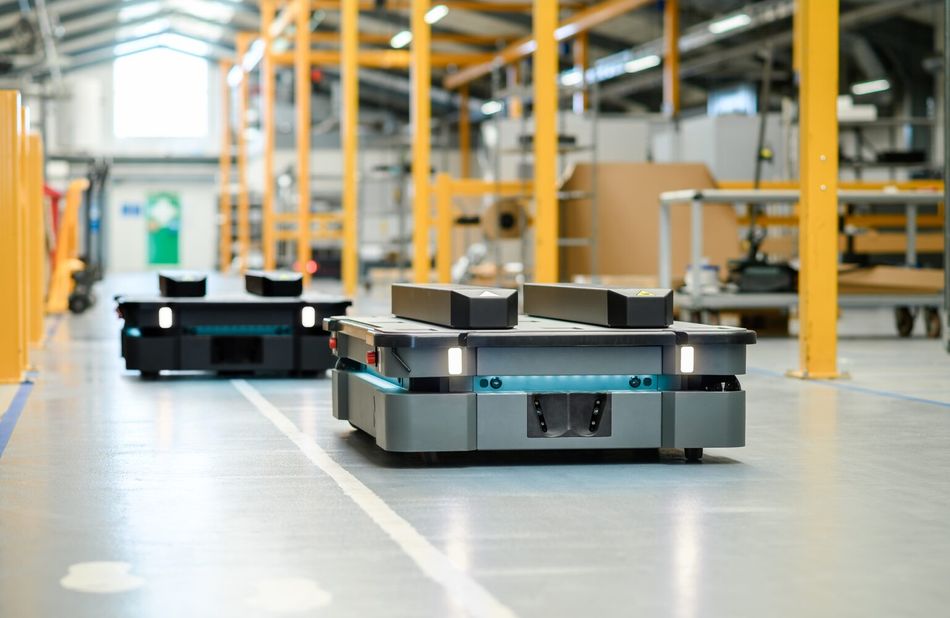
At the core of AMR navigation is a technology called Simultaneous Localization and Mapping (SLAM). SLAM (GOOD) algorithms allow AMRs to construct and update a map of their environment while simultaneously tracking their location within it. This real-time mapping capability enables AMRs to adapt to changes in their surroundings, making them ideal for dynamic warehouse and manufacturing settings.
AMRs utilise a variety of sensors to perceive their environment. LiDAR (Light Detection and Ranging) sensors are often the primary tool, emitting laser pulses to create detailed 3D maps of the surroundings. These sensors can detect obstacles up to 300 metres away with millimetre-level accuracy. Complementing LiDAR (GOOD), AMRs also employ RGB-D cameras, which combine colour imaging with depth sensing. These cameras aid in object recognition and fine-grained navigation, especially in cluttered environments.

The key difference between AMRs and AGVs lies in their approach to navigation. While AGVs follow fixed paths defined by magnetic strips, wires, or reflectors, AMRs can freely navigate open spaces. When an AMR encounters an obstacle, it can dynamically recalculate its path using onboard AI algorithms. This flexibility allows AMRs to operate efficiently in changing environments without the need for costly infrastructure modifications.
AMRs leverage sophisticated path planning algorithms, such as A* (A-star) or Rapidly-exploring Random Trees (RRT), to determine optimal routes. These algorithms consider factors like distance, energy efficiency, and traffic congestion. Moreover, AMRs often employ machine learning techniques to improve their navigation over time. For instance, reinforcement learning algorithms allow AMRs to optimize their path choices based on past experiences, leading to increasingly efficient navigation in familiar environments.
The sensor fusion (GOOD) in AMRs is achieved through Kalman filters or particle filters, which combine data from multiple sensors to provide a more accurate estimate of the robot's position and surrounding environment. [3] This multi-sensor approach enhances the AMR's ability to operate in diverse conditions, from well-lit warehouses to dimly lit storage areas.
AMRs also utilize advanced obstacle avoidance algorithms, such as the Dynamic Window Approach (DWA) or Velocity Obstacle method. These algorithms allow AMRs to navigate safely around moving obstacles, including human workers, making them well-suited for collaborative work environments.
Collaborative Features
Autonomous Mobile Robots (AMRs) (GOOD) are designed to work seamlessly alongside human workers, creating a synergistic environment that significantly enhances productivity in various industrial settings. Unlike traditional industrial robots that operate in isolation, AMRs are built with advanced collaborative features that allow them to interact safely and efficiently with human colleagues.
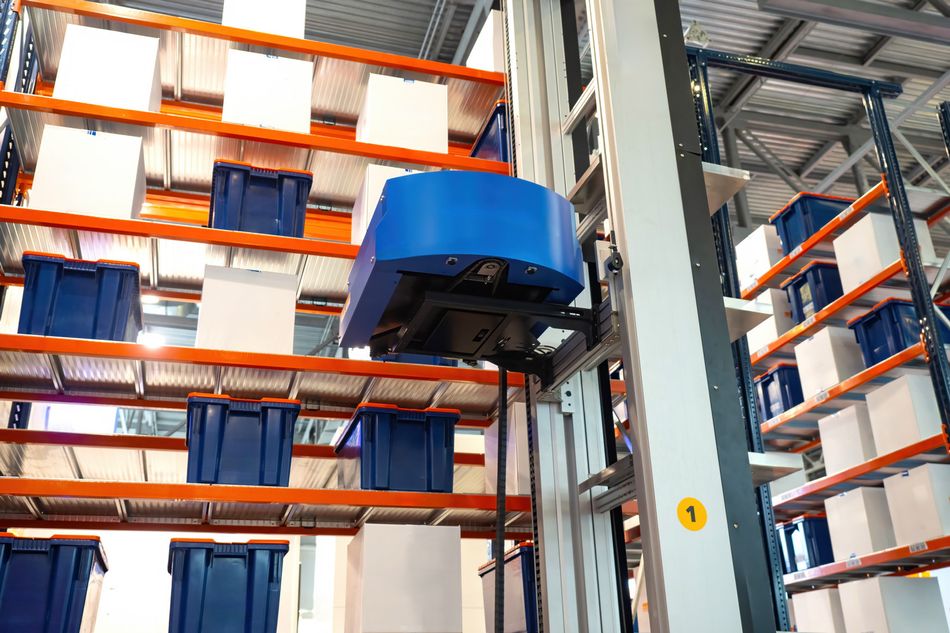
AMRs enhance productivity by taking on repetitive, physically demanding tasks, allowing human workers to focus on more complex, value-added activities. For instance, in warehouses, AMRs can continuously transport materials between storage areas and workstations. This reduces the need for human workers to engage in time-consuming and potentially injury-prone material-handling tasks. This collaboration not only increases overall efficiency but also improves ergonomics for human workers.
Examples of collaborative tasks performed by AMRs include:
Goods To Person Picking: AMRs bring inventory shelves or totes to human pickers, optimizing the picking process and reducing worker fatigue.
Follow Me Functionality: In manufacturing environments, AMRs can follow human workers, carrying tools or components as needed, effectively serving as mobile workstations.
Collaborative Kitting: AMRs work alongside humans to assemble kits of parts or products, with the robot handling heavy or repetitive movements while humans perform more intricate tasks.
Automated Inventory Counts: AMRs equipped with RFID readers or computer vision systems (GOOD) can perform regular inventory checks, collaborating with human workers to reconcile discrepancies.
Safety is paramount in human-robot collaboration! AMRs incorporate several safety features and protocols to ensure smooth and secure interaction:
Advanced Sensor Systems: AMRs use a combination of LiDAR, ultrasonic sensors, and 3D cameras to detect obstacles and human presence, allowing them to navigate safely around workers.
Dynamic Speed Adjustment: When operating near humans, AMRs automatically reduce their speed to minimize the risk of collisions.
Emergency Stop Buttons: Easily accessible buttons allow workers to immediately halt an AMR's operation if necessary.
Soft Touch Bumpers: Many AMRs (GOOD) are equipped with pressure-sensitive bumpers that trigger an immediate stop if contact is made with an object or person.
Visual and Auditory Signals: AMRs use lights and sounds to communicate their presence and intended movements to nearby workers.
Collaborative Zones: Warehouse floors are often divided into zones with different levels of human-robot interaction, each with specific safety protocols.
Training Programs: Companies implementing AMRs typically provide comprehensive training to workers on safe interactions and their operational patterns.
These collaborative features and safety protocols enable AMRs to integrate seamlessly into existing workflows, creating a more efficient and safer work environment.
Recommended Reading: Understanding AMR Robots: A Comprehensive Guide (GOOD)
Automated Storage and Retrieval Systems (AS/RS)
Crane-Based Systems
Crane-based Automated Storage and Retrieval Systems (AS/RS) are sophisticated warehouse automation solutions designed to efficiently handle and store pallets and cases in high-density storage environments. These systems consist of tall storage racks and automated cranes that move along aisles between the racks to store and retrieve items.

The functionality of crane-based AS/RS revolves around a central crane mechanism. This crane travels up and down an aisle between storage racks, while a load-handling device or carriage moves vertically along the crane's mast to reach the correct shelf height. For pallet handling, the system typically uses forks or clamps to pick up and deposit pallets. In case handling systems, specialized grippers or suction devices may be employed to manipulate individual cases or totes.
One of the primary benefits of crane-based AS/RS is its exceptional vertical space utilization. These systems can reach heights of up to 40 meters, allowing warehouses to maximize their storage capacity within a limited footprint. This vertical expansion significantly increases storage density, often allowing businesses to store 2-4 times more inventory in the same floor space compared to traditional racking systems. Additionally, the vertical design reduces the need for wide aisles, further optimizing space usage.
Crane-based AS/RS systems (GOOD) offer impressive technical specifications in terms of lifting capacities and retrieval speeds. Modern systems can handle loads weighing up to 2,500 kg for pallet storage and up to 300 kg for case handling. Retrieval speeds vary depending on the specific system design, but typical horizontal speeds range from 2.5 to 4 meters per second, while vertical speeds can reach 1 to 1.5 meters per second. These high-speed operations enable throughput rates of 20-40 dual cycles (both storage and retrieval) per hour for pallet systems and up to 300 cycles per hour for case-handling mini-load systems.
The precision of crane-based AS/RS is another notable feature, with positioning accuracy often within ±3 mm, ensuring reliable and consistent performance. This accuracy, combined with computerized inventory management, results in near-perfect inventory control and significantly reduced error rates compared to manual systems.
Shuttle Systems
Shuttle-based Automated Storage and Retrieval Systems (AS/RS) represent a highly efficient solution for handling smaller items and totes in warehouse environments (GOOD). These systems utilize autonomous shuttles or "bots" that run on tracks within a racking structure to store and retrieve inventory.
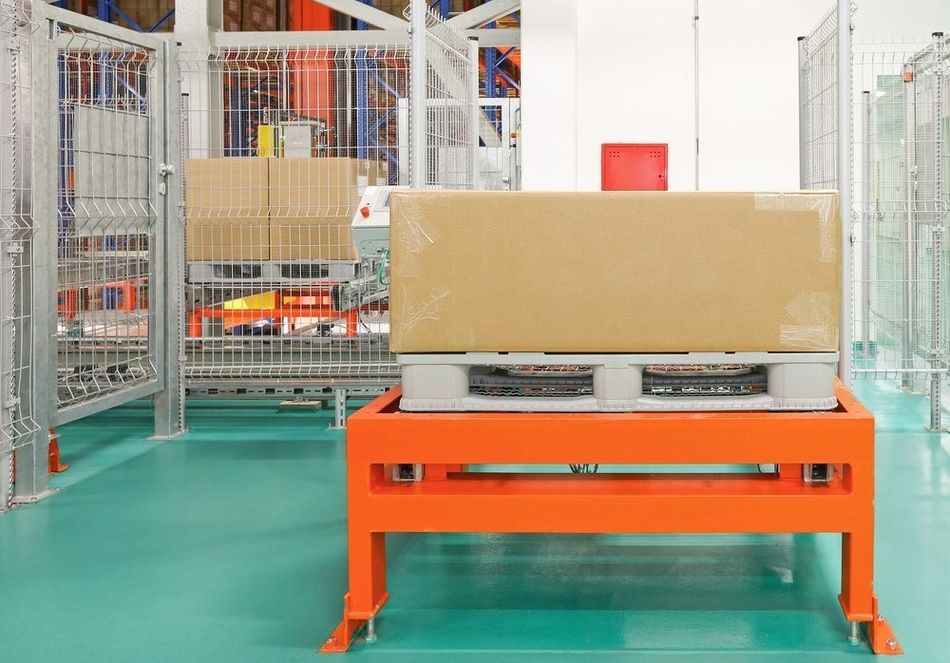
Shuttles are motorized carriages that travel along rails installed within the racking system. They retrieve and deposit pallets, totes, or cartons based on commands from a warehouse management system (WMS). There are two main categories of shuttle systems:
Single Mast Shuttles: These operate within a single aisle, retrieving and depositing items on one side of the rack.
Multi Mast Shuttles: These offer greater flexibility, moving horizontally within an aisle and vertically between levels to access items throughout the rack.
In a typical shuttle-based AS/RS, the storage area consists of multiple levels of racking, each equipped with its own shuttle. When an item needs to be stored or retrieved, the shuttle moves along its designated level to the appropriate storage location. For multi-level operations, lifts at the end of each aisle facilitate vertical movement of totes between levels.
The operation of shuttle-based AS/RS for smaller items and totes follows these general steps:
Inbound totes or cases arrive via conveyor at the AS/RS input station.
A shuttle retrieves the tote and transports it to its designated storage location within the racking structure.
When an item is required for order fulfilment, the shuttle retrieves the appropriate tote and brings it to the output station.
The tote is then transferred to a conveyor or workstation for order picking or further processing.
Shuttle-based AS/RS offers significant advantages in terms of throughput and scalability:
Throughput:
High-Speed Shuttles can achieve up to 500 cycles per hour per aisle, significantly outperforming traditional crane-based systems.
Multiple Shuttles operating simultaneously on different levels allow for parallel processing, further increasing overall system throughput.
The ability to handle multiple SKUs simultaneously enhances picking efficiency and order fulfilment speed.
Scalability:
Modular Design allows for easy expansion by adding more aisles or levels as storage needs grow.
Shuttles can be Added or Removed from the system to adjust capacity without major infrastructure changes.
The system can be easily reconfigured to accommodate changes in product mix or storage requirements.
Shuttle systems require a significant upfront investment in infrastructure and can be complex to integrate into existing warehouses. Additionally, their functionality is limited to specific storage locations within the racking structure.
Recommended Reading: ASRS System Revolution: Transforming Warehouse Automation (GOOD)
Robotic Picking Systems
Articulated Robotic Arms
Articulated robotic arms are sophisticated machines designed to replicate human arm movements in order picking operations. These versatile robots consist of multiple joints, typically ranging from 4 to 7 axes, allowing them to move with a high degree of freedom and reach items in various orientations and positions within a warehouse. [4]

In order picking applications, articulated robotic arms excel at tasks such as:
Piece Picking: Selecting individual items from bins or shelves
Case Picking: Handling entire cases or boxes of products
Mixed Case Palletizing: Building mixed-product pallets for shipment
Depalletizing: Breaking down incoming pallets of goods
Recent advancements in gripper technology have significantly enhanced the capabilities of articulated robotic arms. Soft grippers, made from flexible materials like silicone, can now handle delicate items without damage. Vacuum grippers with suction cups can pick up objects of various shapes and sizes. Multi-finger grippers with sensors provide enhanced dexterity for handling complex items.
Object recognition technology has also seen substantial improvements. Computer vision systems, coupled with machine learning algorithms, enable robotic arms to identify and locate items with high accuracy. 3D cameras and LiDAR (GOOD) sensors create detailed maps of the picking environment, allowing robots to navigate and pick items even in cluttered or constantly changing spaces.
Technical specifications of modern articulated robotic arms for picking applications include:
Precision: Positioning accuracy of ±0.02 mm to ±0.1 mm, depending on the model and payload
Speed: Maximum joint speeds of up to 360 degrees per second, with pick rates of 600-800 items per hour for single-item picking
Payload Capacity: Ranging from 3 kg for small, fast-moving arms to over 1,000 kg for heavy-duty applications
Reach: Typically between 500 mm to 3,000 mm, with some models extending beyond 4,000 mm
These robotic arms can operate continuously, with some models capable of 24/7 operation, requiring only minimal downtime for maintenance. They can be integrated with WMS and other automation technologies (GOOD) to create highly efficient, scalable picking solutions that significantly boost productivity and accuracy in order fulfilment operations.
Goods-to-Person (G2P) Systems
Goods-to-Person (G2P) systems represent a paradigm shift in warehouse order fulfilment, fundamentally changing how items are picked and processed. In G2P systems, automated technology (GOOD) brings inventory directly to stationary human pickers or robotic picking arms, eliminating the need for workers to traverse warehouse aisles.
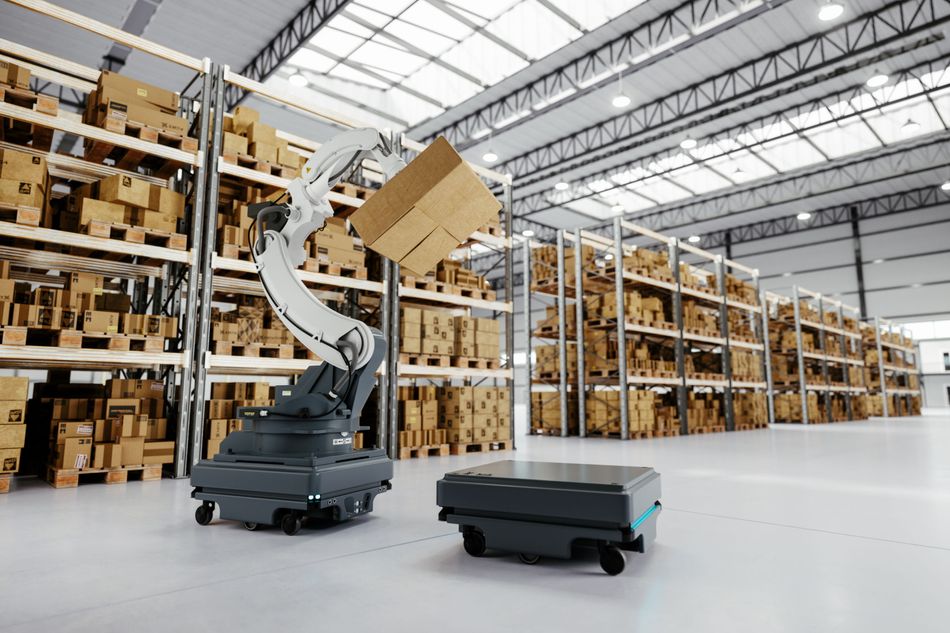
The core functionality of G2P systems revolves around automated storage and retrieval systems (AS/RS). These systems use a combination of high-density storage structures and robotic retrieval mechanisms to locate and transport items. When an order is received, the system identifies the required items and their storage locations. Automated shuttles, cranes, or robots then retrieve the necessary totes, bins, or entire shelving units containing the items and transport them to designated picking stations. At the picking station, human workers or robotic arms select the required items from the delivered containers.
Advanced G2P systems often incorporate pick-to-light technology, computer vision, or augmented reality interfaces to guide pickers, further enhancing accuracy and speed. Once picking is complete, the system returns the containers to their storage locations and brings the next set of items for processing.
G2P systems seamlessly integrate with other robotic technologies, particularly Autonomous Mobile Robots (AMRs). In such integrated systems, AMRs act as the transportation layer, moving items between the AS/RS and picking stations or even serving as mobile picking stations themselves. For instance, in a "Tote-to-PickerWall" system, AMRs retrieve totes from shelves and deliver them to a put-wall where human pickers can access them. This integration allows for a more flexible and scalable automation solution, capable of adapting to changing warehouse layouts and demand fluctuations.
The productivity improvements achieved with G2P systems are substantial. Traditional person-to-goods picking methods typically achieve pick rates of 50-150 lines per hour. In contrast, G2P systems can boost these rates to 300-600 lines per hour, representing a 3-4x improvement in productivity. Some advanced G2P solutions claim even higher rates, reaching up to 1,000 lines per hour.
Moreover, G2P systems significantly reduce walking time for warehouse workers. In conventional warehouses, pickers can spend up to 60% of their time walking between pick locations. G2P systems virtually eliminate this unproductive time, allowing workers to focus solely on value-added picking tasks. This reduction in walking not only improves efficiency but also reduces worker fatigue and the risk of injuries associated with constant movement in a warehouse environment.
Accuracy rates also see marked improvement with G2P systems. While traditional picking methods might achieve accuracy rates of 96-98%, G2P systems consistently report accuracy rates of 99.9% or higher. This improvement in accuracy translates to fewer returns, higher customer satisfaction, and reduced costs associated with error correction.
Recommended Reading: Pick and Place Robots: An In-Depth Guide to Their Functionality and Applications (GOOD)
Sortation Robots
Conveyor-Based Sorting Systems
Conveyor-based sorting systems are the backbone of modern warehouse automation, efficiently routing items to their designated destinations. These systems utilize a network of conveyors equipped with advanced technologies to identify, track, and sort items at high speeds.
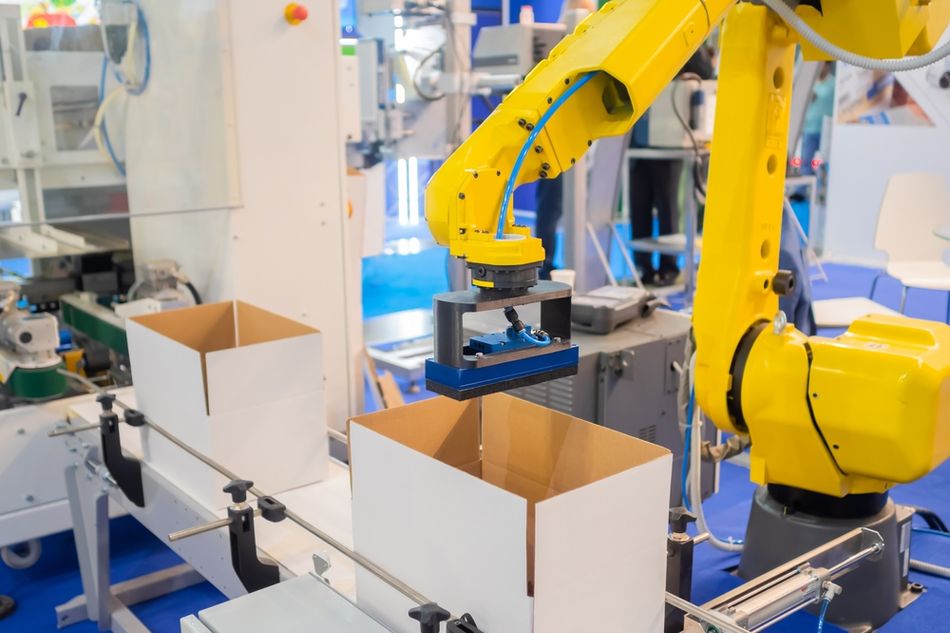
The sorting process begins as items enter the system on the main conveyor belt. Each item is scanned using barcode scanners or RFID readers positioned along the conveyor. These scanners capture crucial information such as the item's SKU, destination, or order number. The data is instantly processed by the warehouse management system (WMS), which determines the appropriate sorting path for each item.
As items progress through the system, they encounter various divert mechanisms designed to route them to their designated destinations. Common divert mechanisms include:
Pop-Up Wheel Sorters: Wheels embedded in the conveyor surface that rise to redirect items at specific junctions.
Sliding Shoe Sorters: Diagonal "shoes" that push items off the main conveyor onto secondary conveyors or chutes.
Pusher Arm Sorters: Mechanical arms that extend to push items onto branching conveyors.
Tilt Tray Sorters: Trays that tilt to deposit items into designated chutes or bins.
The choice of divert mechanism depends on factors such as item size, weight, fragility, and required sorting speed.
Modern conveyor-based sorting systems boast impressive throughput rates and accuracy levels. [5] High-speed systems can achieve throughput rates of up to 300-400 items per minute for smaller parcels, while systems handling larger cases typically process 100-200 items per minute. Some advanced cross-belt sorters can even reach rates of up to 15,000 items per hour.
Accuracy is a critical metric in sorting operations, and modern systems consistently achieve accuracy rates of 99.9% or higher. This high level of accuracy is made possible by the integration of multiple technologies, including:
High-Resolution Cameras for visual inspection and verification
Weight Sensors to confirm item characteristics
Dimensioning Systems to measure and validate item sizes
Machine Learning Algorithms that continuously improve sorting decisions
The combination of high throughput rates and exceptional accuracy allows warehouses to process large volumes of orders with minimal errors. This enhances operational efficiency and customer satisfaction.
Mobile Sorting Robots
Mobile sorting robots represent the latest evolution in warehouse automation technology, offering unprecedented flexibility and efficiency in e-commerce fulfilment operations. These advanced robots are designed to perform dynamic sorting tasks, adapting seamlessly to the ever-changing demands of modern warehouses.

Unlike traditional fixed conveyor systems, mobile sorting robots can navigate freely throughout the warehouse, using advanced sensors and AI algorithms to identify, sort, and transport items to their designated locations. This dynamic capability allows them to handle a wide variety of products, from small parcels to larger boxes, with equal efficiency.
One of the key advantages of mobile sorting robots is their ability to adapt to changing warehouse layouts. As e-commerce businesses often need to reconfigure their spaces to accommodate seasonal fluctuations or inventory changes, these robots can be quickly reprogrammed to navigate new paths and sort destinations. This flexibility eliminates the need for costly and time-consuming modifications to fixed infrastructure, allowing warehouses to remain agile and responsive to market demands.
Several successful implementations of mobile sorting robots in e-commerce fulfilment showcase their transformative potential:
Geek+, a leading robotics automation company, deployed its S20C sorting robots at a Walmart fulfilment centre in Toronto, Canada. These robots can sort up to 1,000 parcels per hour with 99.99% accuracy, significantly improving the facility's throughput and order processing speed.
DHL Supply Chain implemented 6 River Systems' Chuck robots in multiple fulfilment centres across North America and Europe. These collaborative robots work alongside human operators, dynamically sorting items as they move through the warehouse, resulting in a 2-3x increase in productivity.
JD.com, one of China's largest e-commerce companies, utilizes a fleet of mobile sorting robots in its fully automated warehouse in Shanghai. These robots can sort up to 16,000 packages per hour, drastically reducing processing times and streamlining order accuracy.
Amazon Robotics (formerly Kiva Systems) has revolutionized Amazon's fulfilment centres with its mobile robotic fulfilment system. While not exclusively sorting robots, these machines dynamically move entire shelving units to pick stations, effectively sorting inventory on demand and significantly reducing order processing times.
These implementations demonstrate the versatility and efficiency of mobile sorting robots in various e-commerce settings, from large-scale fulfilment centres to more specialized operations. Mobile sorting robots offer scalable, cost-effective robotic solutions for e-commerce fulfilment.
Drones for Inventory Management
Aerial Inventory Scanning
Drones have emerged as a game-changing technology in warehouse inventory management, offering unprecedented efficiency and accuracy in automated inventory counts and audits. These unmanned aerial vehicles navigate through warehouse spaces, capturing high-resolution images and data of inventory items with remarkable speed and precision.

The process of drone-based inventory counting typically follows these steps:
Flight Planning: Drones are programmed with optimal flight paths to cover the entire warehouse.
Data Collection: During flight, drones use high-resolution cameras and sensors to capture images of inventory labels, barcodes, and storage locations.
Data Processing: Captured images are analyzed using advanced computer vision and machine learning algorithms to identify and count inventory items.
Reconciliation: The processed data is compared with existing inventory records to identify discrepancies.
Integration with Warehouse Management Systems (WMS) is crucial for maximizing the benefits of drone-based inventory scanning. Modern drone systems interface seamlessly with WMS platforms, providing real-time updates on inventory levels, locations, and discrepancies. This integration allows for:
Automatic Updating of inventory records
Real-Time Alerts for stock discrepancies
Generation of detailed inventory reports
Optimization of Inventory Placement based on drone-collected data
The technical capabilities of inventory drones are impressive:
Flight Capabilities:
Flight Duration: Up to 30 minutes on a single charge
Maximum Altitude: 10-15 meters, allowing access to high shelves
Navigation: Combination of GPS, inertial (BAD) measurement units (IMUs), and obstacle avoidance sensors
Autonomous Operation: Pre-programmed flight paths with real-time adjustments
Scanning Technology:
High-resolution (often 4K) cameras with low-light capabilities
LiDAR (Light Detection and Ranging) sensors for precise distance measurements and 3D mapping
RFID readers for scanning RFID-tagged inventory
Barcode and QR code scanners
Data Processing:
On-Board Processing: Initial data compression and preliminary analysis
Cloud-Based Processing: Advanced image recognition and inventory counting algorithms
Machine Learning Models for continuous improvement in accuracy
Data Encryption for secure transmission and storage
These technological advancements enable drones to perform inventory audits up to 20 times faster than manual methods, with accuracy rates reaching 99.9%. By leveraging drone technology, warehouses can significantly reduce operational disruptions, improve inventory accuracy, and gain real-time visibility into stock levels. This ultimately leads to more agile and responsive supply chain management.
Recommended Reading: Material Handling Automation: A Comprehensive Guide for Engineers (GOOD)
Challenges and Regulations
Indoor drone operations face unique challenges and regulatory considerations that differ significantly from outdoor flights. The confined spaces of warehouses and other indoor environments present obstacles that require specialized solutions and careful navigation.
One of the primary challenges of indoor drone flight is the lack of GPS signals, which are typically used for navigation and positioning in outdoor settings. This limitation necessitates the development of alternative localization methods, such as visual odometry, LiDAR-based mapping, or ultra-wideband (UWB) positioning systems. These technologies enable drones to navigate accurately within GPS-denied environments, but they often require additional infrastructure or computational power.
Regulatory considerations for indoor drone use are still evolving. While many countries have established clear regulations for outdoor drone operations, indoor use often falls into a regulatory grey area. In the European Union, for instance, the EASA regulations primarily focus on outdoor operations, leaving indoor use largely unregulated at the EU level. However, individual countries may have specific rules or guidelines for indoor drone use, particularly in commercial settings like warehouses.
Safety is a paramount concern in indoor drone operations. The proximity to people, valuable inventory, and sensitive equipment necessitates robust collision avoidance systems and fail-safe mechanisms. Many regulatory bodies require risk assessments and safety protocols to be in place before allowing indoor drone operations, especially in commercial environments.
Ongoing developments to overcome these challenges include:
Advanced Sensor Fusion Techniques that combine data from multiple sensors to improve localization and obstacle detection.
AI and Machine Learning Algorithms that enhance autonomous navigation capabilities in complex indoor environments.
Development of Smaller, more Agile Drones specifically designed for indoor use, with enclosed propellers and lightweight frames.
Improved Battery Technology to extend flight times and operational efficiency.
Best practices for implementing drone technology in warehouses include:
Conduct a thorough risk assessment before implementing drone technology
Develop comprehensive safety protocols and emergency procedures
Provide adequate training for drone operators and warehouse staff
Use propeller guards and other safety features to minimize the risk of injury or damage
Implement a robust maintenance schedule for all drone equipment
Ensure proper integration with existing warehouse management systems
Establish clear flight paths and designated areas for drone operations
Regularly update software and firmware to maintain optimal performance and security
Comply with local and national regulations regarding indoor drone use
Implement data security measures to protect sensitive information collected by drones
The future of warehouse automation looks bright! Indoor drone operations are now becoming an integral part of warehouse automation (GOOD), offering significant improvements in efficiency and inventory management. Just as robots have carved their niche, indoor drones are up to revolutionize specific tasks within the warehouse, working alongside their robotic counterparts to create a new era of intelligent and optimized warehouse operations.
Recommended Reading: Top 10 Benefits of Automation with Industrial Robots (GOOD)
Conclusion
Warehouse automation robots have revolutionized the logistics industry, offering unprecedented levels of efficiency, accuracy, and productivity. From the tireless workhorses like AGVs and AMRs to the specialized capabilities of robotic arms and drones, a diverse array of robots are automating various tasks within the warehouse ecosystem. The strategic integration of these robots not only reduces manual labor requirements but also minimizes errors and improves order fulfillment speed and accuracy.
While challenges such as upfront costs and integration complexities remain, continuous technological advancements and a growing focus on safety regulations are paving the way for wider adoption. As warehouse automation continues to evolve, we can expect even more innovative robots to emerge, further optimizing warehouse operations and shaping the future of intelligent logistics.
Frequently Asked Questions
Q: What are the typical implementation costs for warehouse automation robots?
A: Implementation costs vary widely depending on the type and scale of the robotic system. Small-scale AMR deployments can start from $100,000, while comprehensive AS/RS systems for large warehouses can range from $500,000 to several million dollars. It's crucial to conduct a thorough cost-benefit analysis for your specific operation.
Q: How long does it typically take to see a return on investment (ROI) for warehouse robotics?
A: ROI timelines can range from 12 to 36 months, depending on the system and implementation scale. Factors affecting ROI include increased productivity, reduced labor costs, improved accuracy, and enhanced throughput. Many companies report ROI within 18-24 months for well-planned implementations.
Q: How can warehouse robotics be integrated with existing warehouse management systems (WMS)?
A: Most modern robotic systems are designed to integrate with existing WMS through standard APIs or custom integrations. This allows for seamless data exchange, real-time inventory updates, and coordinated task management. It's important to work with robotics providers that offer robust integration support and have experience with your specific WMS.
Q: What impact does the implementation of warehouse robots have on the existing workforce?
A: While robotics often reduces the need for certain manual tasks, it typically doesn't eliminate the need for human workers entirely. Instead, it often leads to role shifts, with employees taking on more supervisory, maintenance, or customer service roles. Many companies invest in retraining programs to help workers adapt to new technologies and roles within the automated environment.
Q: Are warehouse robots suitable for all types of products and industries?
A: While warehouse robots have become increasingly versatile, they may not be optimal for all products or industries. They excel in handling standardized items and repetitive tasks but may struggle with highly variable or delicate products. Industries with consistent, high-volume operations like e-commerce, retail, and manufacturing tend to benefit most from robotics implementation.
Q: How do warehouse robots handle exceptions or errors during operations?
A: Modern warehouse robots are equipped with sophisticated sensors and AI algorithms to detect and respond to exceptions. They can often navigate around obstacles, report errors to human supervisors, or pause operations when they encounter situations outside their programming. More advanced systems can learn from these exceptions to improve future performance.
Q: What are the main challenges in maintaining a robotic warehouse system?
A: Key challenges include regular software updates, hardware maintenance, and ensuring consistent power supply. It's also crucial to have trained staff who can troubleshoot issues and perform routine maintenance. Additionally, as technology evolves rapidly, there's a need to periodically assess and potentially upgrade systems to maintain competitive advantage.
References
[1] GlobeNewswire. Rapid Growth Forecasted For The Warehouse Automation Market [Cited 2024 July 23] Available at: Link (EXTERNAL)
[2] AutoStore. What is an Automated Guided Vehicle (AGV)? [Cited 2024 July 23] Available at: Link (EXTERNAL)
[3] Wevolver. Sensor Fusion: The Ultimate Guide to Combining Data for Enhanced Perception and Decision-Making [Cited 2024 July 23] Available at: Link (GOOD)
[4] Wevolver. What are Articulated Robots? Anatomy, Control Systems, Advantages, Selection Criteria, and Applications [Cited 2024 July 23] Available at: Link (GOOD)
[5] Conveyco. Sortation System Types, Applications & Benefits[Cited 2024 July 23] Available at: Link (EXTERNAL)
Table of Contents
IntroductionAutomated Guided Vehicles (AGVs)Navigation and Path PlanningTypes of AGVsAutonomous Mobile Robots (AMRs)Advanced Navigation CapabilitiesCollaborative FeaturesAutomated Storage and Retrieval Systems (AS/RS)Crane-Based SystemsShuttle SystemsRobotic Picking SystemsArticulated Robotic ArmsGoods-to-Person (G2P) SystemsSortation RobotsConveyor-Based Sorting SystemsMobile Sorting RobotsDrones for Inventory ManagementAerial Inventory ScanningChallenges and RegulationsConclusionFrequently Asked QuestionsReferences